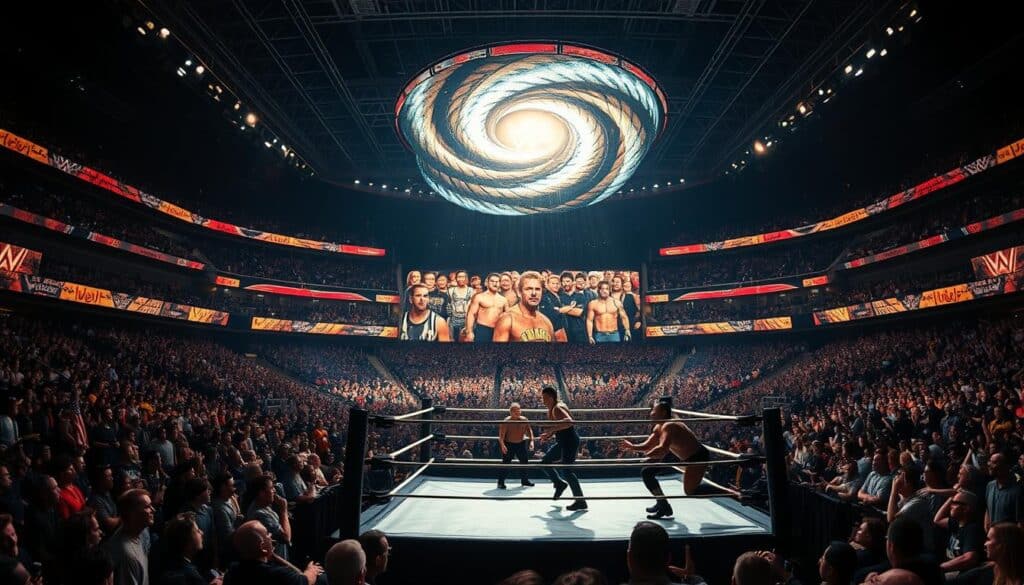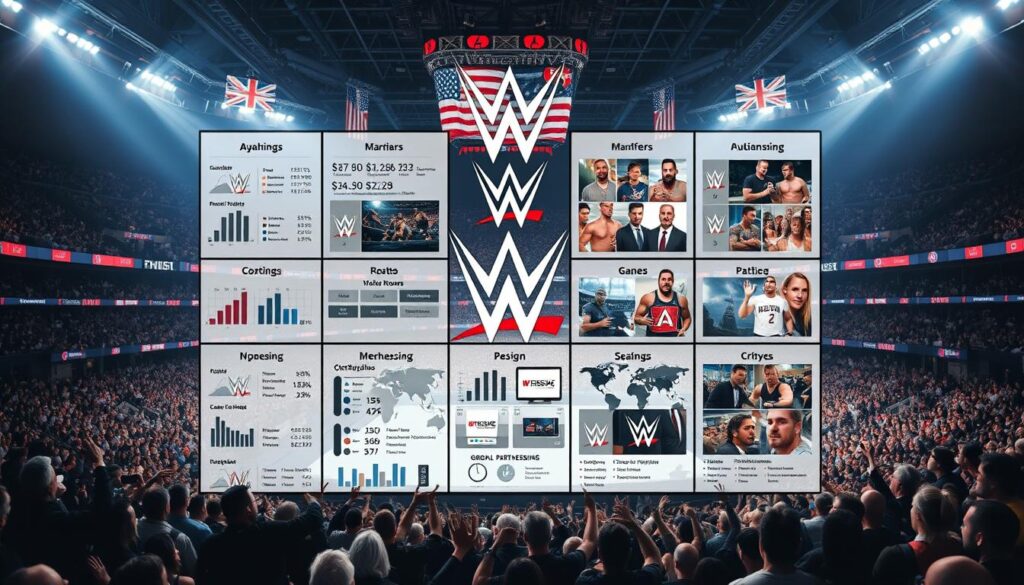What started as a carnival act now rules global pop culture. It’s like a steel chair to the skull. The sports entertainment empire changed the game, using its own rules.
Vince McMahon, the mastermind, mixed circus fun with business tactics. He made a huge impact. His creation is like a drama show with steroids.
Championship belts are like ancient relics. Rivalries are like corporate dramas, with body slams instead of boardroom battles. This cultural juggernaut grew from small wrestling shows to a global streaming giant.
The magic is making people care about spandex-clad shows. Monday Night Raw’s bright lights show America’s true self. It’s about ambition, betrayal, and redemption, all through wrestling.
But there’s more to it. The WWE Network saved wrestling history. It’s like a modern folklore. Storylines are so real, even Wall Street talks about Stone Cold Steve Austin’s sayings.
This isn’t just entertainment. It’s a mix of business and sports. Crowd reactions shape the company’s plans. And, you might say WWE phrases without knowing it. That’s a big hold on today’s culture.
Origins and Evolution
Sequined robes, steroid scandals, and crypto bros share a common thread. They’re all part of WWE’s journey from a carnival sideshow to a global entertainment giant. Let’s explore how wrestling evolved from dusty tents to “Can’t See Me” merchandise, filled with twists and turns.
From Carnivals to Crypto: 1963-2024
The WWE’s story is like a Stan Lee comic. It began with regional promoters, like feudal lords, and territories divided like a mafia. Vince McMahon, a mix of PT Barnum and Gordon Gekko, changed everything. His 1982 takeover was a cultural shift.
The steroid trial era was WWE’s awkward phase. Hulkamania’s muscular physiques were more than just hard work. They symbolized the excess of the 80s. WWE had to change, leading to the Attitude Era’s rebellious characters. It was a bold move, like a Netflix series.
The Titan Emerges: McMahon’s Hostile Takeover (1982)
McMahon didn’t just buy WWE; he consumed it. He saw TV as the key to success, not just live events. His approach turned wrestling into a drama series. Today, WWE is a $10B giant, making famous WWE wrestlers stars.
The Montreal Screwjob (1997) was a turning point, blending reality and TV. Today, WWE uses internet trends like Thanos collecting Infinity Stones. From DX to Logan Paul, WWE adapts fast.
| Era | Hero Archetype | Revenue Driver |
|---|---|---|
| Golden Age (80s) | All-American Strongman | PPV Events |
| Attitude Era (90s) | Rebellious Antihero | TV Rights |
| PG Era (00s) | Family-Friendly Superstar | Merchandise |
| Social Media Era | Influencer-Athlete Hybrid | Streaming Subs |
Even McMahon’s failures taught WWE valuable lessons. The XFL’s failure led to NXT’s global talent hunt. WWE’s Performance Center now trains entertainers like a Marvel factory.
Importance in Pro Wrestling
Pro wrestling isn’t just about who wins. It’s about how we’re convinced to care. WWE mixed Shakespearean drama with body slams, creating sports entertainment. This mix turned wrestling into America’s longest-running soap opera with amazing stunts.
Kayfabe to Meta: Storytelling’s Great Work
The match between Randy Savage and Ricky Steamboat at WrestleMania III was more than a fight. It was a three-act tragedy in spandex. Steamboat, the underdog, faced Savage, the narcissist, in a drama-filled battle.
Years later, John Cena and Roman Reigns had a long story. Fans didn’t accept Reigns as the new hero because WWE forgot to explain why. The audience’s boos showed they wanted better storytelling.
Choreographed Violence as High Art
Mick Foley’s 1998 Hell in a Cell fall was like performance art. His injuries, including a tooth stuck in the mat, made the audience feel something. Sasha Banks’ 2020 Iron Woman match was another example of wrestling as drama.
Is the Canadian Destroyer a new form of poetry in wrestling? When Ricochet does a 630 Senton, he’s not just jumping. He’s writing poetry with his body. WWE’s magic is making us question if a suplex is character development.
- WrestleMania’s “Stone Cold” Rebellion: Steve Austin’s beer truck hijack was a class struggle with stunners
- NXT Takeover’s Technical Ballet: Gargano vs. Ciampa showed hatred can be choreographed in ¾ time
- The Yes Movement’s Organic Roar: Daniel Bryan’s underdog story made crowd chants part of the story
WWE’s real trick is making us forget it’s all scripted. It’s about the craft behind the scenes. Wrestling isn’t about being real—it’s about how well it’s done.
WWE’s Impact on Popular Culture
What connects Andy Kaufman’s 1983 slap fight with Jerry Lawler to Bad Bunny’s table-slamming move? Both show how sports entertainment tricks us by blending into our minds with strategic absurdity.
The Rock’s famous eyebrow didn’t just spark memes. It also opened doors in Hollywood. His move from People’s Champion to a box office star shows how sports entertainment can turn into global hits. John Cena’s salute also crossed over, becoming a symbol of unity.
Bianca Belair’s braids are more than hair. They’re a symbol of Black strength. Her moves echo through history, making her a true icon. But Zack Ryder’s early YouTube days also show how anyone can make a mark.
The Immortals mobile game shows our love for myths. It lets us control gods, blending circus and social experiment. It’s a place where everything from military shows to Pokémon cards can thrive.
The Business and Brand of WWE
Let’s explore how Vince McMahon turned body slams into billions. His sports empire is like a corporate ladder match. Every division fights for the top, while shareholders watch from the front row.
Forget about championship belts. This is all about making money and big licensing deals. It’s like Stone Cold Steve Austin’s beer-chugging days are old news.
TV rights fees are the big winners, making up almost 80% of WWE’s income. But what happens when live events start losing popularity? Saudi Arabia’s big deals are like the Money in the Bank briefcase of today’s sports world. It’s a mix of controversy and big money.
Merchandising the Muscle
Stephanie McMahon didn’t just inherit her dad’s smile. She turned WWE stars into digital treasure hunters. Now, championship belts are digital collectibles. It’s like owning Roman Reigns’ virtual bling is cool.
The Tribal Chief’s success in the ring also boosts earnings. He’s not just winning matches; he’s making money.
Peacock’s $1B Bet on Bodyslams
The WWE Network moved to Peacock for $1 billion. It’s not just about streaming wrestling. It’s about making money from nostalgia and attracting new viewers.
This deal is like a high-risk move in wrestling. It hasn’t failed yet. But can it last as long as The Undertaker’s streak? Only time will tell.
Analysis of WWE’s Competition
The sports entertainment world is like a steel cage full of hungry fighters and old champions. Let’s grab our folding chairs and look at how today’s wrestling wars are like corporate America’s battle between old ways and new ideas.
Grappling With Globalization
Today’s wrestling promotions face a big choice: Go global or get left behind. Big names rely on old favorites, while new ones focus on going viral and finding talent worldwide. It’s like Survivor Series, where everyone thinks they’ll be the last one standing.
The real battle is behind the scenes. Is it better to grow your own stars through tough training programs or to buy talent from indie promotions? And why do concussion protocols seem like a big debate in wrestling, but not much action?
Think about this: AEW’s weekly shows might make WWE’s big events seem like reruns of Monday Night Raw‘s best days. But for every new star on Twitter, there’s a Brock Lesnar comeback that boosts sales. The real question is, do fans even know who’s winning anymore?
Holograms and Hyperreality: WWE’s Next Frontier
WWE’s future is like stepping into a Black Mirror episode. Imagine watching Stone Cold Steve Austin’s hologram take down Roman Reigns in your VR headset. Fan votes, powered by blockchain, could decide who wins title shots.
The company’s mobile gaming strategy might turn into augmented reality matches. Your living room could become the Royal Rumble entrance ramp.
When Andre Meets AI
Vince McMahon’s love for the big show meets modern tech at the Performance Center. Motion-capture rigs train NXT recruits with digitized Bret Hart moves. But can ChatGPT write better promos than Triple H?
Current algorithms can create promos as sharp as 1997 Rock’s. Yet, they can’t match Mick Foley’s charm.
Tokenized Fandom and Lunar Suplexes
WWE history hints at moon matches sponsored by Prime Energy. But first, we need to figure out the ethics. The real money is in tokenized crowd reactions, turning live events into crypto markets.
As AEW grows, WWE’s Netflix deal might lead to interactive specials. Viewers could choose who turns heel. The squared circle is turning into a Tron grid. Let’s hope the humanity in wrestling survives.


